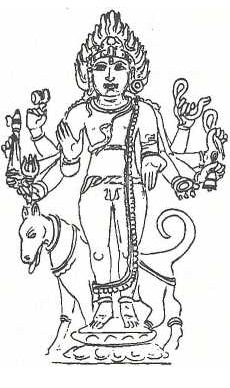Kṣetrapala
From Hindupedia, the Hindu Encyclopedia
By Swami Harshananda
Kṣetrapala literally means ‘guardian of the site’.
The Kṣetrapāla occupies an important place among the subsidiary deities in the temples of Śiva . He is the chief guardian of the temple. His appearance can be described as below:
- His idol is usually naked.
- He has protruding eyes.
- He exhibits sharp fangs in the mouth.
- He has disheveled hair.
- Snakes are his ornaments.
- He is shown with two or four or even six hands carrying:
- Sword
- Bell
- Trident
- Noose
- Skull-cup
- Fire
- He stands on a lotus.
- He is accompanied by a dog.
- He is worshiped first before commencing the regular service of the day.
- He seems to be an aspect of Bhairava.
- He may have three aspects according to the three guṇas:
- Sattva
- Rajas
- Tamas
- He can also be an independent deity with his own shrine usually set up in the north-eastern corner of the village or town.
- His shrine should not face east.
References[edit]
- The Concise Encyclopedia of Hinduism, Swami Harshananda, Ram Krishna Math, Bangalore

